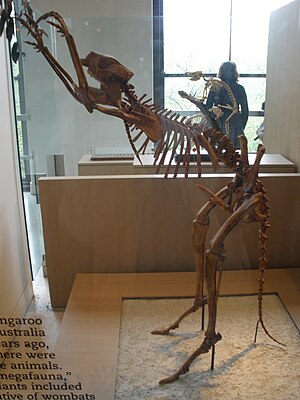Simosthenurus
| Simosthenurus | ||||||||||||
|---|---|---|---|---|---|---|---|---|---|---|---|---|

Skeleton of Simosthenurus |
||||||||||||
| Temporal occurrence | ||||||||||||
| Late Miocene to late Pleistocene | ||||||||||||
| approx. 5 million years to approx. 50,000 years | ||||||||||||
| Locations | ||||||||||||
| Systematics | ||||||||||||
|
||||||||||||
| Scientific name | ||||||||||||
| Simosthenurus | ||||||||||||
| Tedford , 1966 | ||||||||||||
Simosthenurus was a genus of large, extinct kangaroos . The animals lived in Australia until the late Pleistocene.
features
The scientific name Simosthenurus refers to the kangaroo genus Sthenurus , as the subgenus of which it was first described. Simo - means something like short-nosed.
The animals had relatively short snouts and extremely strong chewing muscles. Possibly they were adapted to tough plants in the arid regions of Australia. The largest species, such as Simosthenurus pales, weighed up to 100 kg and were therefore larger than all kangaroos living today.
Types and distribution over time
The species that survived into the late Pleistocene include Simosthenurus occidentalis and Simosthenurus browneorum . The oldest representatives of the genus are known from the early Pliocene.